Techniques of Wearing Working Women's Clothing.
We wanted to gather a collection of images to study how everyday working women's costume was worn. We want to study how Apron's were wrapped, skirts were tucked and caps were mounted. There seems to be a lot of consistencies in some of the working women in painting and we'd like to see if we can plot them and see how consistent they really are.
Fishmongers - Nebot - 1737. We seem to like our Fish Stalls! What we did like about this painting is our lady here in the lined Gown. Although there are hints to her being slightly wealthy, she does wear her skirts pinned back and with the contrast lining it means this causes a nice kind of decoration. We'd love to know how they pinned the skirts back - we can use our imagination but it would be nice to know for sure! She also wears a plain red pett and her gown's an Anglais with what looks like puff-pad detail around the sleeves and contrast Cuffs. She wears a pearl/beaded necklace and under cap tied on with ribbon and the obligatory Bergere hat.
- Also just a quick interesting note - this appears to be the first painting we've seen that verifies the fact that the ribbons over the cap were indeed tied at the back of the neck. It seems an interesting point but until this image we could only guess at this - it's nice to have proof!
- Also just a quick interesting note - this appears to be the first painting we've seen that verifies the fact that the ribbons over the cap were indeed tied at the back of the neck. It seems an interesting point but until this image we could only guess at this - it's nice to have proof!
Our Next image is a Paul Sandby Image and one we have well used. Part of his sketches for a possible series on The Cries of London, this watercolour has been dated 1759 and is of a Black Cherry Seller. This la dy is a little better dressed than some in the Cries of London and the general details include:
dy is a little better dressed than some in the Cries of London and the general details include:
- Brown-ish Robe a l'Anglais with possible cuff detail. Gown pinned back.
- Striped pett.
- Light coloured pocket and blue apron, looks to be just tied around waist.
- Some kind of cap with possible lappets or is an undercap as this could just be a cloth and a ribbon tied round.
- Striped neck cloth.
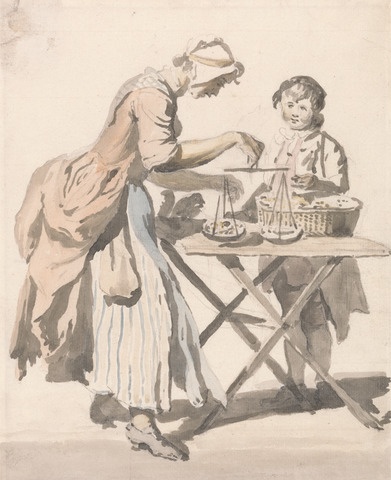 dy is a little better dressed than some in the Cries of London and the general details include:
dy is a little better dressed than some in the Cries of London and the general details include:- Brown-ish Robe a l'Anglais with possible cuff detail. Gown pinned back.
- Striped pett.
- Light coloured pocket and blue apron, looks to be just tied around waist.
- Some kind of cap with possible lappets or is an undercap as this could just be a cloth and a ribbon tied round.
- Striped neck cloth.
- Looks to be wearing Stays
- Plain shoes
- Plain shoes
But Details specific to how she wears her clothing is:
- She is wearing the skirts of her gown pinned back - quite steeply so that much of her petticoat is revealed. Also she has no coloured lining.
- Her apron is blue and long and starts from under her gown by all appearance.
- The pocket is to the side in the place one would assume it to be
- Her neck cloth is not very full, lying quite flatly against her back and not really showing many signs of it being at her front.
- She is wearing the skirts of her gown pinned back - quite steeply so that much of her petticoat is revealed. Also she has no coloured lining.
- Her apron is blue and long and starts from under her gown by all appearance.
- The pocket is to the side in the place one would assume it to be
- Her neck cloth is not very full, lying quite flatly against her back and not really showing many signs of it being at her front.
The next image is one we've used over and over again through-out our research. It's not our fault; there's just so many important details contained within it, we have to keep using it as 'an example of...'.
For example, she has been one of the initial images for our plain pocket product and it was her that first made us notice the cross-over straps at her chest. But...lets start afresh here and give her details again:
- Plain light coloured petticoat - could be shift but it's very long and much heavier looking. Did think at one point it could be her Apron but the blue thing is in fact her apron.
- It's a fascinating way of wearing an apron. We've noticed this technique in other paintings - both with Aprons and with their skirts or petticoats. We don't know how they kept them up! We know it appears in this image as if it's her arm but in the next image; Wheatley's Cries of London, you can see that the lady painted there is doing this with her skirts also and it doesn't appear to be just a temporary thing - the lady in Wheatley's painting is concentrating on something else but her skirts are still wrapped round her.- Back to our Mackeral Seller, her apron being tucked up in this manner reveals her pocket and you get the impression that this could be part of the reason - or atleast a useful side effect.
- Her cloak is worn off her shoulders and tied at her neck. We don' tknow what the cords are from - we are guessing her cloak as in other images it also appears to be the cloak but it could be to hold up the apron. It's certainly not from her basket which some images also show.
- Her shift sleeves are ragged and cuffless, displaying their width of cut.
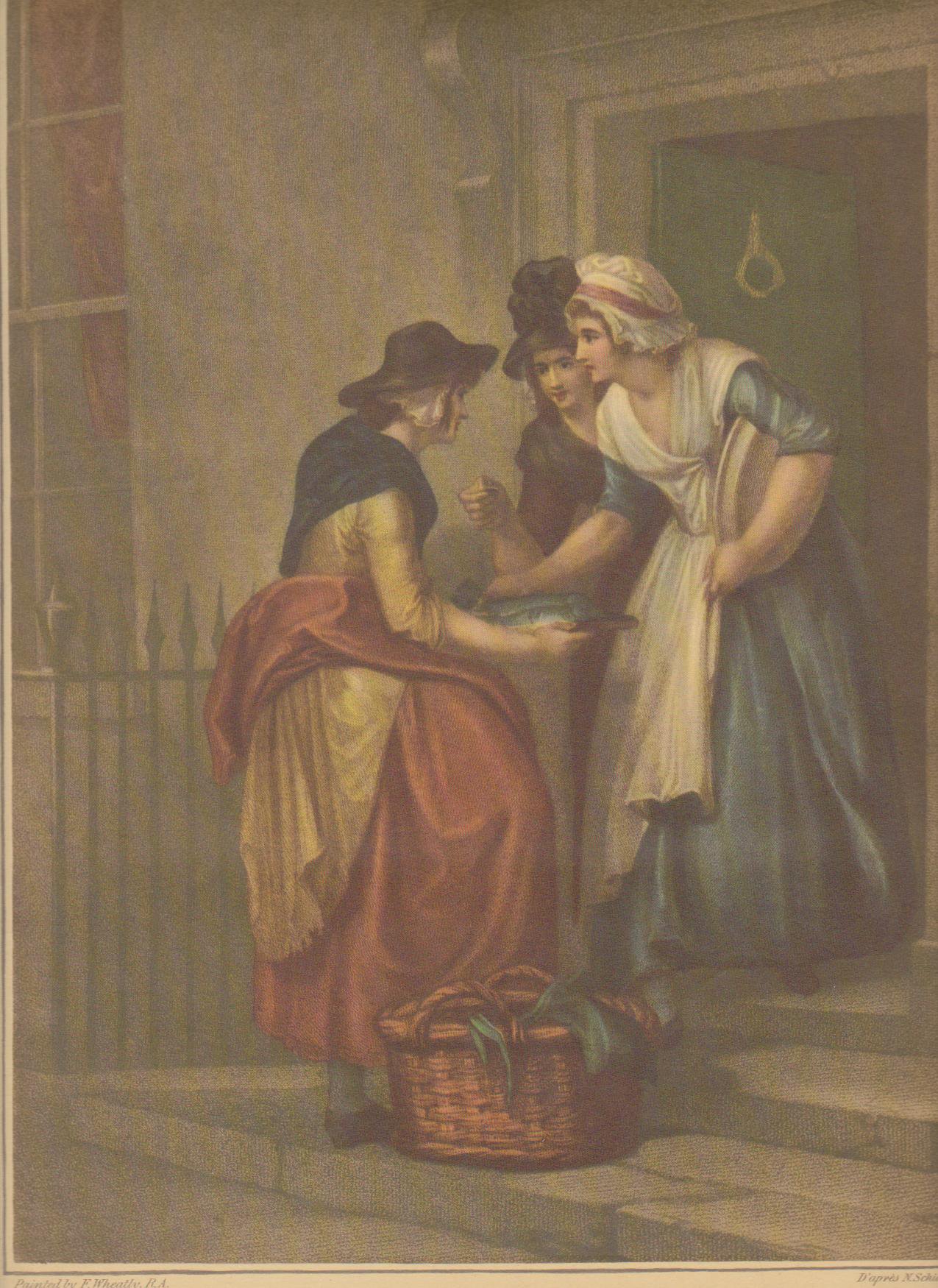 Next: Painted in 1793 - this series by Francis Wheatley: 'The Cries of London' shows women about 30 years later than those of Paul Sandby's images. Though 30 years have passed these images still contain a lot of similarities, not just in the general items of working women's clothing but in how they were worn also.
Next: Painted in 1793 - this series by Francis Wheatley: 'The Cries of London' shows women about 30 years later than those of Paul Sandby's images. Though 30 years have passed these images still contain a lot of similarities, not just in the general items of working women's clothing but in how they were worn also.
In this image you have 3 women. 2 of them we are mainly going to be looking at as the third looks to be a little better dressed and also has less seen of her. So: the Mackerel Seller. - The V&A who houses Paul Sandby's 'Mackerel Seller' detail how her smelliness and the offense she causes by her mere presence is shown by the dog retaliating to her (not shown in the image above) and by the horrified looks of the door she's near. This image however contains nothing of that. She looks well dressed, full of a sense of servant-hood and seems to be useful to the maid(?) who is looking at her products.
- She is wearing a rather short Anglais(?) gown in yellow that only hangs at the back to her lower knee level.- Her brick-red coloured petticoat is ankle length but must also be the same garment that wraps so fully around her hips. How this is done we have no idea - it's either pulling up her skirts at the front to reveal her knees! or it's an extra, super full skirt (unlikely) or a way of pulling the skirt fullness to one side and wrapping it round - in short we don't know yet. We can't even figure out how it's kept up unless it's pinned (like the first image) or tucked through the pocket openings. How they didn't ease their way back out again is anyone's guess and how it didn't make the skirt tight is also an open question and how it wasn't annoying! is also one we've yet to investigate. However this style crops up time and time again so it must've been useful to the wearer and a way of controlling her flapping skirts while she worked.
- She wears a dark, possibly navy, handkerchief about her shoulders.
- No ruffles or seen shift ends at her sleeves.
- Her hair is worn natural and looks to be in a loose bun kind of way with a undercap being worn with Round Ears or a short lappet - we're not fully au fait with the difference yet! On top of this all is a plain ugly brown straw hat - you can clearly see the difference here between this hat which shouts 'working woman' to the neat Bergere hats with their crisp shallow crown and wide brim.
- She wears grey looking stockings and plain brown shoes.
- Yet her clothes seem in fairly good nick - there could be a little bit of ragging at the back of her gown skirts - it's hard to see but the rest of her is plain, simply dressed, working colours but clean and in good order.
- She wears grey looking stockings and plain brown shoes.
- Yet her clothes seem in fairly good nick - there could be a little bit of ragging at the back of her gown skirts - it's hard to see but the rest of her is plain, simply dressed, working colours but clean and in good order.
The maid is wearing a plain blue gown - (both working ladies wear gowns cut to the shape of this later period but not in the full fashion of the 90s) - hers seems longer than our Mackerel Seller and is a lovely full looking Blue.
- Her Apron is either one that comes up to her chest and is pinned up with the neckerchief wrapped over the top or it's tied on at the waist with the neckerchief pinned across her chest and tucked into the waist line.
- She holds her apron up with one hand - done very naturally and like she's well used to doing it and carries a tray under her left arm.- Her Apron is either one that comes up to her chest and is pinned up with the neckerchief wrapped over the top or it's tied on at the waist with the neckerchief pinned across her chest and tucked into the waist line.
- None of the ladies show any glimpse of white under their sleeves from the shift or ruffles so possibly reflecting this form of fashion.
- She wears a cap of the 90's and 80's style and it appears to be made of a soft, fine linen in the way that it hangs and looks a little limp.
- She also has a her hair finely visible - as if it's been scraped back loosely and strands have worked their way.
 The next image is by the same artist - Francis Wheatley and is from the same collection of paintings. this lady is entitled 'The Cherry Seller'. We've also used this in our Examples of Working Women in Stays as she seems rather evidently to be in Stays and Petticoats alone. So lets detail what she's wearing:
The next image is by the same artist - Francis Wheatley and is from the same collection of paintings. this lady is entitled 'The Cherry Seller'. We've also used this in our Examples of Working Women in Stays as she seems rather evidently to be in Stays and Petticoats alone. So lets detail what she's wearing:
- She's in a white shift with rather full sleeves looking like they've been rolled up and tucked in (her left arm).
- She has a red-ish petticoat - not tucked up in anyway shape or form.
- She is aso wearing a blue apron, tied at the waist that has the left hand (her left) corner tucked into the tie.
- She has a white handkerchief round her shoulders and a white undercap on under her hat - which looks to be a little more floppy straw hat than a fashionable Milkmaid or Bergere Straw Hat.
- Her Stays are plain brown and don't have any visible straps.
- She has a red-ish petticoat - not tucked up in anyway shape or form.
- She is aso wearing a blue apron, tied at the waist that has the left hand (her left) corner tucked into the tie.
- She has a white handkerchief round her shoulders and a white undercap on under her hat - which looks to be a little more floppy straw hat than a fashionable Milkmaid or Bergere Straw Hat.
- Her Stays are plain brown and don't have any visible straps.
The next image is entitled 'The Sportsman's Refreshment' and was painted around 1775 by Francis Wheatley.
The yellow lady in front:
- Has the skirts of her dress pinned together at the front - this is really useful because it's probably similar to how they pinned it when it was done at the back. You can see the effect this pinning causes - this rucked up skirts around the hip area and making the yellow skirts sit almost at thigh height. This pinning also happens at waist level - covering over the CF point of the gown.
- She wears a pink petticoat - looks fairly heavy so could be quiltedor wool.
- She has plain sleeves, pulled up slightly over her elbow and no frill or glimpse of the shift.- She wears a pink petticoat - looks fairly heavy so could be quiltedor wool.
- Her Neck cloth (apparantly ladies in the 18th century just referred to it as a Handkerchief until the 80's went it became the Fichu- Cunnington's) hangs at it's point at the back and is met together with something at the front of her gown just above the neckline. It then either sits slightly crossed over so that it covers the CF opening. It has a striped edge.
- She wears a Mob Cap with pinkish Ribbon and interestingly this sits completely over her hair - the ribbon alone must've held it on or else a hair pin or something.
The lady in the background looking on and holding a plate of bread wears her neck cloth crossed over her chest and probably pinned into that position.
- She wears a floppy looking country hat with either an Undercap with lappets or a cap with lappets - don't ask us about the differences; we're too are still figuring that out!- She wears a darkish looking green robe with a darkish looking green neck cloth and a little glimpse of her shift at the neckline.
- Cherry seller - Wheatley - 1793
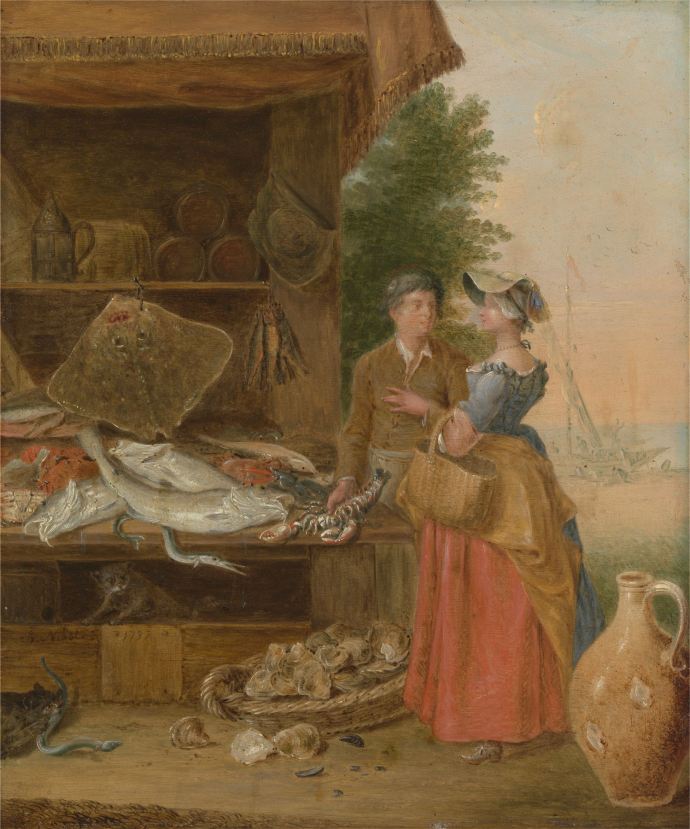
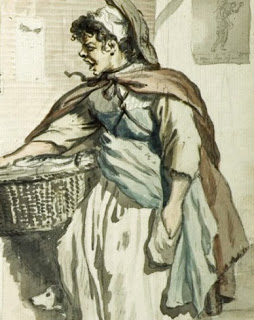
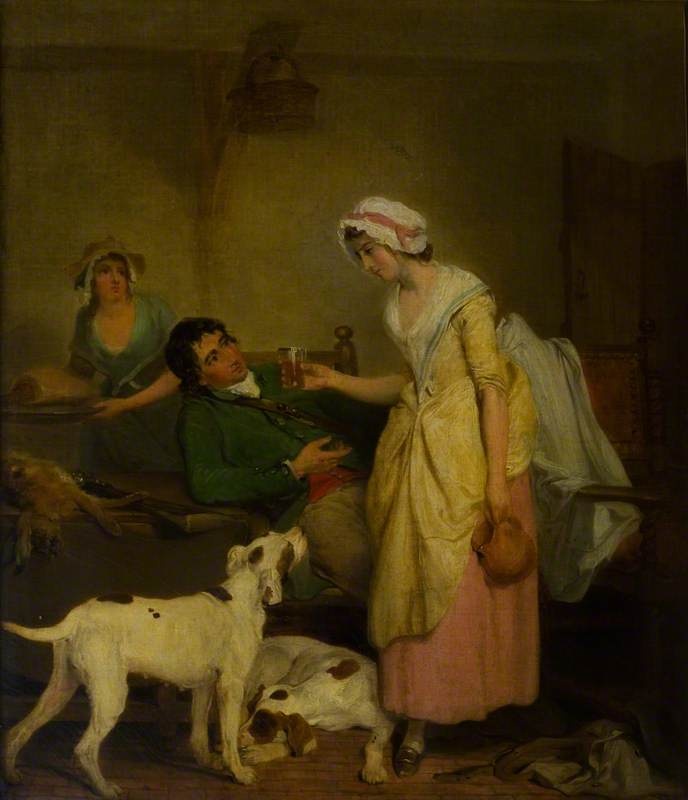
No comments:
Post a Comment